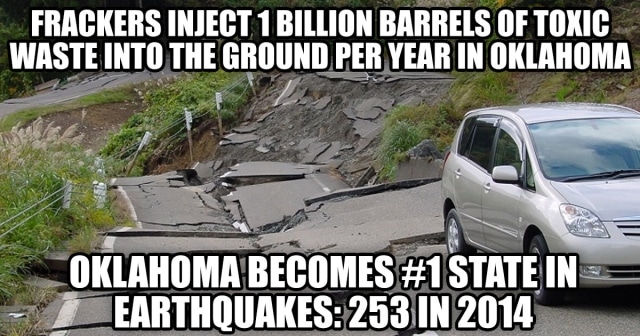Last weekend, a swarm of seven earthquakes in just 14 hours between Saturday evening and Sunday morning in Oklahoma made national headlines.
Those seven quakes were immediately preceded by another earthquake that measured 4.3 on the Richter scale in Langston, OK, which struck at noon on Saturday. And on Monday, a quake that measuring 3.9 hit just northeast of Harrah, OK, followed in the same region just hours later by a 3.8 magnitude earthquake, data from the U.S. Geological Survey shows.
The ground in Oklahoma keeps shaking, and state, federal and independent researchers have pointed to the shale gas rush as the likely culprit for many of the tremors. Some in the state have called for a halt to fracking and wastewater injection. Others are pushing to allow the injections to continue in the hopes that more research will allow scientists to pinpoint what makes individual disposal wells pose greater or lesser risks.
The problem highlights the intractability of one of the biggest problems created by fracking and drilling: what to do with the over 660 billion gallons of oil and gas industry wastewater created every year, largely by the rush to drill for shale oil and gas. The most common answer is to pump the waste deep underground, but a growing body of research shows that the process is causing earthquakes nationwide.
Over the past seven days, Oklahoma has experienced more than 20 earthquakes, roughly half of them over 3.0 magnitude, USGS data reveals. These quakes are usually small, with little immediate damage reported, but homeowners say they fear for their foundations and some larger earthquakes over the past several years have led to hospitalizations from falls. The 4.3 magnitude quake on Sunday shattered windows and cracked the walls of a local police station.
Oklahoma has had more earthquakes than any other state in the U.S. this year, shaken by more than double the number of tremblers that have hit California, a state twice its size that sits atop the notoriously active San Andreas fault line.
Back in 2003, Oklahoma was ranked 17th in earthquake frequency, but now, the magnitude 3.0 or stronger earthquakes that used to strike twice per year have hit over 253 times already in 2014, more than once per day.
“It’s truly remarkable, we’ve never seen anything like this,” Austin Holland of the Oklahoma Geological Survey told CNN. “This is completely unprecendented.”
State and federal geologists say that the shale drilling rush may be to blame, pointing out that the swarms of earthquakes cannot be explained by fault lines alone. “The recent earthquake rate changes are not due to typical, random fluctuations in natural seismicity rates,” a USGS report warned in May.
Peer-reviewed research by independent scientists has also reached the conclusion that fracking and wastewater injection may be causing the quakes, with one study published earlier this month in the journal Science suggesting a cluster of more than 100 quakes was caused by four injection wells. The epicenter of some quakes was more than 20 miles away from the injection wells, much further away than wells were previously though capable of causing.
Prior to the shale gas rush, the strongest earthquake ever recorded in Oklahoma was a 5.5 magnitude trembler that hit on April 9, 1952. But in 2011, a 5.7 magnitude quake hit in Prague, OK, causing two structures to collapse, buckling highways and cracking buildings. That quake, USGS researchers later announced, may have been triggered by a 5.0 magnitude quake the day before that was induced by the injection of wastewater from the shale industry.
Oklahoma is home to more than 10,000 oil and gas wastewater injection wells, which combined force more than 1 billion barrels of toxic waste into the ground per year.
With this much wastewater, pressures underground can rise, causing swarms of quakes, researchers say. “You really don’t need to raise the pressure a great deal,” Cornell University seismologist Katie Keranen, one of the authors of the Science paper told SciTech Today.
Imagine a sponge between two stiff wooden blocks, her colleague Shemin Ge, a hydrogeology professor at the University of Colorado, Boulder suggests. The “more fluid you put in, the more pressure the sponge has to deal with,” she told the Los Angles Times. Over time, “the area or volume within the sponge around the injection point will expand.”
And when it does, the consequences for those on the ground could become increasingly severe, federal scientists say.
USGS researchers warned this year that injecting fracking wastewater underground could lead to significant seismic events, and that a series of small quakes can set off a much bigger one. “The observation that a human-induced earthquake can trigger a cascade of earthquakes, including a larger one, has important implications for reducing the seismic risk from wastewater injection,” said USGS seismologist and coauthor of the study Elizabeth Cochran said in March, when research into the Prague quake was announced.
The risk of larger earthquakes has experts concerned about the impacts on homes and businesses in a state where, unlike California, little attention was previously paid to earthquake risk during construction projects.
Earthquake experts now warn that these structures could be at risk. “Building owners and government officials should have a special concern for older, unreinforced brick structures, which are vulnerable to serious damage during sufficient shaking,” Dr. Bill Leith, Senior Science Advisor for Earthquakes and Geologic Hazards at USGS, said in May.
Indeed, some Oklahoma real estate developers have begun adding seismic braces, which may cost $20,000 a piece, to support each brick or masonry column in older buildings.
Fear of the quakes, along with the costs of protecting against them, have begun to lead to a public outcry, even in a state that historically has had strong ties to the oil and gas industry.
In late June, residents of Edmond, OK, population 84,000, jammed a public meeting to standing-room only capacity when state earthquake experts arrived to discuss the risks. When one expert told the crowd that simply ordering a halt to wastewater injection would mean scientists could not collect valuable data, the crowd erupted in outrage. “You want to study us like animals,” one man objected. “Do you want a 7.0 (earthquake) that leveled Haiti to occur in the middle of Edmond?”
Some scientists say they hope to better understand the quakes so that they can predict which injection wells will cause problems, and which will not. One seismologist has even proposed deliberately setting off an quake for research purposes.
“We don’t know how to evaluate the likelihood that a [fracking or wastewater] operation will be a seismic source in advance,” Gail Atkinson who studies Earthquake Hazards and Ground Motions at Western University in Ontario, Canada, told National Geographic.
Unsurprisingly, shale industry representatives have backed proposals for further study, which would allow wastewater injection to continue. “Sound research and good data can help inform the industry and improve its operations to further reduce risk,” Steve Everley, a spokesman for Energy In Depth, told Reuters last year.
The Oklahoma Corporations Commission, which regulates the industry, approved new rules that would require wastewater injection operators to track the amount of waste they pump underground each day, instead of each month as before. State regulators have very rarely ordered an injection well shut down all-together.
“There is a real dearth of regulations,” Prof. Atkinson told Science Daily in May. “We need a clear understanding of the likely induced seismicity in response to new activity. And who is the onus on to identify the likely seismic hazard?”
Subscribe to our newsletter
Stay up to date with DeSmog news and alerts







